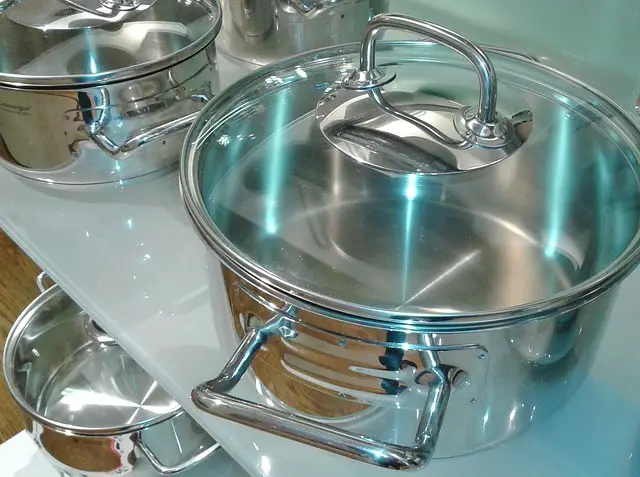This post contains affiliate links. When you buy through our links, we may earn a commission.
It would only take you a meal to realize that you have no idea how to cook with stainless steel cookware. That burned, disappointing meal cooked in a steel pot says it all. Of course, that doesn’t mean you dump your stainless steel cookware and probably opt for something else. A little knowledge of how to cook with stainless steel pans should make it all fun and easy for you. It isn’t something out of the blues. Within no time, you should figure it out and make the perfect meals.
But must you use stainless cookware? Well, the non-stick pots are much easier to use, but the non-stick has been linked to cancer, you wouldn’t want to take the risk. Therefore, you may just have to damp your non-stick cookware and go stainless. Of course, it isn’t going to be easy to adapt, but with a few tips on how to cook with stainless steel cookware, you should be good to go.
If you’re one of those people who find it hectic cooking with stainless steel pans, the following tips should make the cooking much easier for you.
How To Cook With Stainless Steel Pans

1. Cook At Low Temperatures
Stainless steel cooking pans are made in such a way that the sides and the bottom heat evenly. This means the food is being cooked from more than one direction. When you cook at high temperatures, you subject the food to excess heat. As such, the food either gets overcooked or burnt. If you were using a non-stick pan before, you may have to set your burner a little lower than you used to, depending on the heat requirement for the recipe.
2. Don’t Skip Preheating
Unlike non-stick pans that require less to no preheating time, with stainless steel cookware, preheating is a must. While you may not see the pores, stainless steel is usually porous when cold. It’s the edges of these pores that cause the food to stick, and, therefore, it’s important to close the pores first before you start cooking. The only way you can do this is by preheating the pan. This leads to the expansion of the stainless steel, which causes the pores to close giving you a smooth cooking surface.
3. Don’t Add Oil Before Preheating
You might be used to pouring oil on your non-stick pan without preheating, but with stainless steel, that’s a big disaster. If you add oil to the pan before its preheated, the oil will sink into the pores and it will make your food stick. Wait until the pan is hot enough, then pull it off the burner before adding oil. Swirl it around and return it to the burner. It shouldn’t take long to heat this small amount of oil. Within a few seconds, you’re ready to start cooking.
4. Preheat The Right Way
If you aren’t sure how long you should preheat the pan, use the water drop test. Heat the pan until its rim is too hot to touch, then splash a drop of water. If the drop stays in a ball and rolls around the pan, then you’re good to go. Remember, the pan can easily overheat soon after preheating. Therefore, have your ingredients ready and toss them on the pan immediately after preheating.
5. Cleaning After Cooling
When exposed to extreme temperatures, stainless steel can easily warp. This leads to an uneven cooking surface which may just interfere with your cooking. Therefore, don’t run cold water on your just-used pan or pan. Let it cool by itself before you wash it. Well, you may want it to cool a little quickly so that nobody gets burnt the next minute, but that’s not the right way to do it. So, give it time to cool.
6. Keep Away The Metal Scrubbers
You may want some extra cleaning for your pan but just stick to non-metal scrubbers. Metal scrubbers like steel wool leave little particles on the stainless steel. These particles are subject to rusting and may end up staining the surface of your pan. Additionally, metal scrubbers are a bit abrasive, and so, they can scratch the surface of your stainless steel pan. Therefore, use plastic scouring pads, brushes, scrubbers, or soft cloth for general cleaning. You can also sprinkle some baking powder if you’re looking for that extra shine.
7. Rinse Properly
Give your stainless steel pan a proper rinse. Unlike the non-stick types, stainless steel pans and pots easily get stained. Dirty water can leave some residue on the surface of your stainless steel cookware. When these particles accumulate on the surface of your pan or pot, they can cause food to stick when cooking. So, make sure you rinse your pots and pans completely. Use clean water, and if possible, running water to do this ensuring all dirt particles are removed.
8. Don’t Add Salt Before Boiling
Adding salt to the water on a stainless pan before heating can lead to pitting. These are tiny bits of rust on the surface of the pan. Pitting is irreversible, and so, you may have a rough time cooking until you get a new pan. So, simply avoid it by adding salt once the water boils. However, add little amounts at a time as adding salt to boiling water can cause it to over boil.
9. Replace Old Pans
Cleaning and scrubbing subject your stainless steel pan to wear and tear. With time the surface of the pan becomes thinner. You’ll realize that it overheats easily, causing the food to burn. Regulating the heating temperatures could help, but sometimes it just won’t work. Therefore, just replace your pans and pots if you realize the cooking surfaces are thinning put. However, check the stainless steel cookware review or best stainless steel cookware available in the market before taking one home.
How To Cook and Season Stainless Steel Pans Video
Conclusion
Stainless steel cookware is the best for cooking. However, you must know how to cook with stainless steel Pans to avoid burned food. You want your guests to enjoy the meal, and so, get the knowledge.
